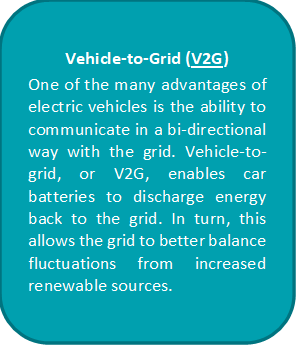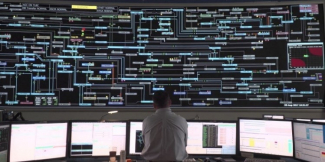

By Bryan Evans | Wed, March 23, 22
I can remember when my twin and I used to run around our home as children, turn off all the lights, unplug all the appliances, and scream, “saving electricity!” While I do not know the origin of why we started doing this, I am sure my parents enjoyed saving some power. Years later in university, I learned about all the work that goes into “keeping the lights on” and having the grid run efficiently. A couple more years and here I am, writing about how homeowners can save even more money and power using smart energy technologies.
Let’s begin with a refresher on how homes receive power. The electric lines that distribute power to your home might not look so pretty on the side of the highways or on our streets, but this is how residential, commercial, and industrial customers receive their power. Simply put, the grid is a chain of interconnected power lines that carry power from generators and transmit it – through long distance, high voltage power lines – to lower voltage distribution lines that bring power to our homes.
However, most of the electric grids we see today have been around for well over 50 years and did not account for the increase of renewable energy sources like wind and solar power. Throughout the region, states are committed to decarbonizing the grid, introducing new and innovative market designs, systems, and technologies to meet demand. But as long as power is available when folks want it, most of this means nothing to the everyday consumer.
“Turning on a light switch is a simple act that masks a very complex system” – Dan York, ACEEE
Stability and reliability are key for the grid. Fluctuations inherent in renewable energy sources, coupled with national initiatives like electrifying everything, have the potential to cause issues with electricity stability if not well-managed. Keeping the power on is not an easy ask without new, innovate strategies to keep up with demand.
One strategy formally known as grid modernization, refers to making the grid “smarter” and more resilient through the use of cutting-edge technologies, equipment, and controls that communicate and work together to deliver electricity more reliably and efficiently. This can make the system more efficient day-to-day, reduce the frequency of power outages, and help restore service faster when outages do occur.
So, what does saving energy and costs while increasing control and reliability look in a regular home?
Smart Technology Highlight: Battery Storage & Electric Vehicles
At the time of this blog, there are 13,192 customers dealing with power outages throughout the Northeast and Mid-Atlantic. This is on what can be called a “normal” day, one with no major storms or weather events that would likely cause greater impacts on the grid and homes. Whether a power outage is a couple hours or even days or week, they are inconvenient and can be dangerous. During Hurricane Sandy, my home in New Jersey was one of the lucky ones that did not lose power, but I got to see the destruction firsthand. All of my friends lost their power and my house became a center to stay warm, microwave food, and charge devices.
In order to protect homes from the impacts of power outages, they must have the ability to store power. Home-scale batteries are used to store electricity from the grid or produced by a home's solar PV system or other renewable sources. This allows homeowners to use the home's energy produced by their solar PV system on demand at a later time (e.g. at night, during power outages) and store it when they don’t use it. On a similar note, electric vehicle (EV) chargers are machines that use electricity to charge plug-in electric vehicles. Electric vehicles can act as a home energy storage device where the batteries can be charged and discharged when necessary, either to the home or back to the grid. Enabling the integration of solar PV, batteries, and EV chargers can create a more efficient, resilient, and flexible power grid that protects homes from foreseeable power outages.
Roles in Smart Energy Homes
As demand for electricity continues to increase, power grid operators such as ISO-New England have the difficult task of ensuring that enough power is being delivered to homes to meet that demand.
Home energy batteries, EV storage, and connection with a "smart" grid allows for two-way communication between utilities and customers. Home energy management systems (HEMS) – software or hardware that monitors and provides timely feedback on home energy usage and enables advance controls of energy-using systems and devices in homes, like heating/cooling systems, appliances, and plug loads – can help optimize this communication. For example, HEMS can help manage EV chargers to charge and discharge at beneficial times throughout the day or manage optimal times to store energy. Additionally, EVs play a key role and can act as flexible loads that are able to store energy during non-peak vs. peak demand hours (e.g. vehicle-to-grid technology as outlined above). Schneider Electric unveiled its Square D Energy Center that allows for integrated service for solar, batteries, and EV chargers, and features whole-home controls that simplify monitoring home energy use, even when the grid is down.
Battery Storage & Electric Vehicle Spotlight
As cities across the region set out ambitious energy and climate goals, Burlington, Vermont has become a leader in net zero energy goals, and has been recognized by the Smart Electric Power Alliance (SEPA) as having the “first US Net-Zero 2030 plan.” One of the key strategies that the Burlington Electric Department (BED) outlined in its Net Zero Energy Roadmap is a strong focus on increasing electric vehicle adoption. BED will use metering from Wi-Fi connected EV chargers to access their stored data through an application programming interface (API) to determine rates for interval charging. Data is used to determine when charging occurred and what credit should be provided back to customers. Furthermore, Green Mountain Power, the largest electric utility in Vermont, offers programs and rebates for electric vehicles and home energy storage.
Resources
For more resources on how to begin the solar PV process, check out U.S. Department of Energy’s (U.S. DOE) Planning a Home Solar Electric System and Homeowner’s Guide to Going Solar. Keep in mind, you can optimize your installation by pairing it with a battery storage device when reviewing options for your solar PV system.
Throughout the Northeast and Mid-Atlantic, a handful of states offer rebates and programs for home energy batteries and EV chargers. Check out NEEP’s Regional Retrofit Program Matrix for available rebates and programs. When shopping for a home energy battery, refer to SolarReviews’ Solar Battery Buyer’s Guide: How to Choose the Right Home Battery. This brief but informative article provides key factors to consider including capacity rating, power rating, round-trip efficiency, lifespan, battery type, safety rating, and costs.


